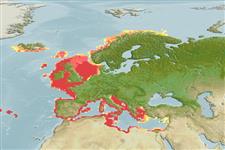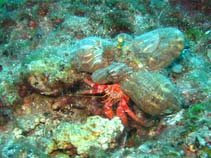Calliactis parasitica (Couch, 1844)
'Parasitic' anemone| Native range | All suitable habitat | Point map | Year 2050 |

|
| This map was computer-generated and has not yet been reviewed. |
| Calliactis parasitica AquaMaps Data sources: GBIF OBIS |
Classification / Names Common names | Synonyms | CoL | ITIS | WoRMS
Anthozoa | Actiniaria | Hormathiidae
Environment: milieu / climate zone / depth range / distribution range Ecology
Sessile. Subtropical
Distribution Countries | FAO areas | Ecosystems | Occurrences | Introductions
Atlantic and the Mediterranean.
Length at first maturity / Size / Weight / Age
Maturity: Lm ? range ? - ? cm
Short description Morphology
Column Size: 8 to 10 cm in height. Column: robust and cylindrical. Color: whitish or yellowish, with a dozen broad longitudinal brown scratches. Tentacles: 3 cm long; yellow gray, slightly transparent; they are numerous. Aconties: long irritant purple filaments; projected with each shock or contact (Ref. 363).
Column Size: 8 to 10 cm in height. Fishing is done artisanalement, with the dredger. Consumed primarily in Sicily. The species meets on all the Mediterranean circumference between a few meters and a hundred meters, on sandy-muddy or detrital substrates (Ref. 363). Known from infra- and circalittoral as well as bathyal zones (Ref. 85338). Solitary (Ref. 2377).
Life cycle and mating behavior Maturity | Reproduction | Spawning | Eggs | Fecundity | Larvae
Members of the class Anthozoa are either gonochoric or hermaphroditic. Mature gametes are shed into the coelenteron and spawned through the mouth. Life cycle: The zygote develops into a planktonic planula larva. Metamorphosis begins with early morphogenesis of tentacles, septa and pharynx before larval settlement on the aboral end.
Main reference
References | Coordinator | Collaborators
Vacelet, J. 1987. (Ref. 363)
IUCN Red List Status (Ref. 130435)
CITES status (Ref. 108899)
Not Evaluated
CMS (Ref. 116361)
Not Evaluated
Threat to humans
Human uses
| FishSource |
Tools
More information
Internet sources
BHL | BOLD Systems | CISTI | DiscoverLife | FAO(Publication : search) | Fishipedia | GenBank (genome, nucleotide) | GloBI | Gomexsi | Google Books | Google Scholar | Google | PubMed | Hexacorallians of the World | Tree of Life | Wikipedia (Go, Search) | Zoological Record
Estimates based on models
Preferred temperature
(Ref. 115969): 7 - 15.7, mean 10.2 (based on 332 cells).
Price category
(Ref. 80766):
Unknown.



